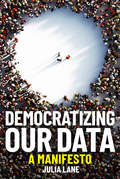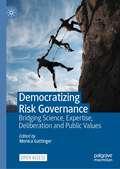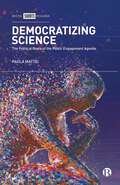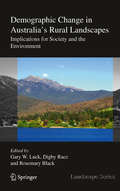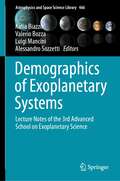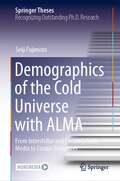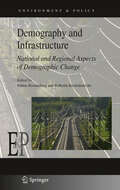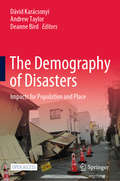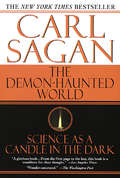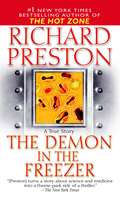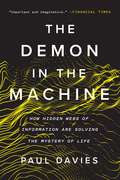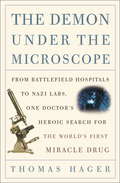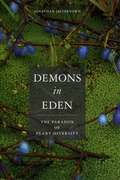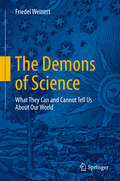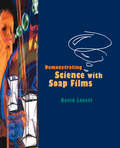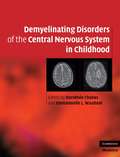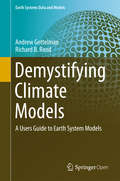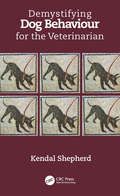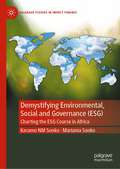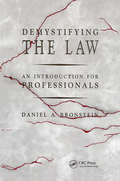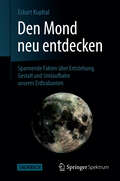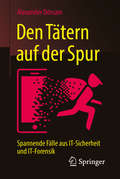- Table View
- List View
Democratizing Our Data: A Manifesto
by Julia LaneWhy America's data system is broken, and how to fix it.Why, with data increasingly important, available, valuable and cheap, are the data produced by the American government getting worse and costing more? State and local governments rely on population data from the US Census Bureau; prospective college students and their parents can check data from the National Center for Education Statistics; small businesses can draw on data about employment and wages from the Bureau of Labor Statistics. But often the information they get is out of date or irrelevant, based on surveys--a form of information gathering notorious for low response rates. In A Data Manifesto, Julia Lane argues that bad data is bad for democracy. Her book is a wake-up call to America to fix its broken public data system.
Democratizing Risk Governance: Bridging Science, Expertise, Deliberation and Public Values
by Monica GattingerThis open access book features contributions from a multidisciplinary team of leading and emerging scholars focused on democratization of risk assessment, management, and communication. The volume identifies and sheds light on key risk governance dilemmas related to public trust, risk perception and public participation. The first part of the book articulates the relationship among science, expertise, deliberation and public values, featuring an in-depth analysis of the concept of ‘motivated reasoning,’ and the role of trust, values and worldviews in understanding and addressing contemporary controversies over risk decision-making. The volume’s second part features eight case studies from three policy fields – energy, genomics, and public health – and a special section dedicated to vaccine decision-making for Covid-19. Chapters analyze the level, nature and mechanisms of public involvement in risk decision-making, assessing its contribution to the effectiveness and legitimacy of decisions. The case studies focus predominantly on Canada, but they draw on global scholarship and are of direct relevance for scholars and practitioners of risk governance in any country.
Democratizing Science: The Political Roots of the Public Engagement Agenda
by Paola MatteiPublic trust in the scientific community is under extraordinary pressure. Crucial areas of human activity and public policy, such as education, universities, climate and health care are influenced by populist political strategies rather than evidence-based solutions. Moreover, data-driven methods are becoming increasingly subject to delegitimization. This book examines potential remedies for improving public trust and the legitimacy of science. It reviews different policy approaches adopted by governments to incentivize the empowerment of stakeholders through co-production arrangements, participatory mechanisms, public engagement and interaction between citizens and researchers. Offering an original analysis of the political roots of the governmental impact and engagement agenda, this book sheds much-needed light on the wider connections to democracy.
Demographic Change in Australia's Rural Landscapes
by Rosemary Black Gary W. Luck Digby RaceThroughout history, humans have lived primarily in rural landscapes. In 2008, for the first time, the global population became predominantly urban. While much research has focussed on the impacts of increasing urbanisation, we have very little knowledge of the implications of these changes for rural landscapes. Global trends suggest populations in rural landscapes are, relatively speaking, in decline. Yet this broad trend is too simplistic and can be very misleading for researchers, land managers and policy makers. This generalisation often masks a much more complex and dynamic process of demographic change, with some rural areas increasing in popularity and experiencing new environmental pressures. The patterns of change can be broadly characterised in two ways: population decline and dissolving rural communities; and amenity-led in-migration (or counter-urbanisation) - a trend identified in developed regions such as North America and Australia. Both of these patterns have substantial implications for the management and sustainability of rural landscapes and communities. This book examines broad and local-scale patterns of demographic change in rural landscapes, identifying some of the drivers of these changes using local case studies, and outlining the implications of changes for society and the environment. The book adopts an interdisciplinary approach by explicitly linking demographic change with environmental, land-use, social and economic factors. The book will provide a useful resource for researchers and graduate students interested in urban development, sustainability science, landscape studies and demographic change, as well as environmental management, human and physical geography and rural sociology.
Demographics of Exoplanetary Systems: Lecture Notes of the 3rd Advanced School on Exoplanetary Science (Astrophysics and Space Science Library #466)
by Valerio Bozza Luigi Mancini Alessandro Sozzetti Katia BiazzoThis book provides a detailed, state-of-the-art overview of key observational and theoretical aspects of the rapidly developing and highly interdisciplinary field of exoplanet science, as viewed through the lenses of eight world-class experts. It equips readers with a broad understanding of the complex processes driving the formation and the physical and dynamical evolution of planetary systems. It juxtaposes theoretical modeling with the host of techniques that are unveiling the exceptional variety of observed properties of close-in and wide-separation extrasolar planets. By effectively linking ingenious interpretative analyses to the main factors shaping planetary populations, the book ultimately provides the most coherent picture to date of the demographics of exoplanetary systems. It is an essential reference for Ph.D. students and early-stage career researchers, while the scope and depth of its source material also provide excellent cues for graduate-level courses.
Demographics of the Cold Universe with ALMA: From Interstellar and Circumgalactic Media to Cosmic Structures (Springer Theses)
by Seiji FujimotoThis book presents the cold side of the Universe illustrated by the rest-frame, far-infrared emission with Atacama Large Millimeter/submillimeter Array (ALMA). The author constructed the largest-ever ALMA sample and dataset, which enables them to identify very faint, rest-frame, far-infrared dust continuums as well as the carbon fine-structure line emission from distant galaxies that have been missed in previous surveys. The observational findings described in this book reveal for the first time where and how much of the star formation, traced by the rest-frame far-infrared emission, is ongoing, from inter-stellar and circum-galactic media to cosmic structures. Moreover, since some of the findings are unexpected and as such challenge the current galaxy formation models, the book provides exciting questions that should be addressed in the next decades.
The Demography and Causes of Blindness
by Hyman GoldsteinA report on the statistics of blindness from an international point of view.
Demography and Infrastructure
by Wilhelm Kuckshinrichs Tobias KronenbergPopulation ageing has been going on for many decades, but population shrinking is a rather new phenomenon. The population of Germany, as in many other countries, has passed a plateau and is currently shrinking. Demographic change is a challenge for infrastructure planning due to the longevity of infrastructure capital and the need to match supply and demand in order to ensure cost-efficiency. This book summarises the findings of the INFRADEM project team, a multidisciplinary research group that worked together to estimate the effects of demographic change on infrastructure demand. Economists, engineers and geographers present studies from top-down and bottom-up perspectives, focusing on Germany and two selected regions: Hamburg and Mecklenburg-Western Pomerania. The contributors employed a broad range of methods, including an overlapping-generations model for Germany, regional input-output models, an energy systems model, and a spatial model of the transportation infrastructure.
The Demography of Disasters: Impacts for Population and Place
by Dávid Karácsonyi Andrew Taylor Deanne BirdThis open access book provides worldwide examples demonstrating the importance of the interplay between demography and disasters in regions and spatially. It marks an advance in practical and theoretical insights for understanding the role of demography in planning for and mitigating impacts from disasters in developed nations. Both slow onset (like the of loss polar ice from climate change) and sudden disasters (such as cyclones and man-made disasters) have the capacity to fundamentally change the profiles of populations at local and regional levels. Impacts vary according to the type, rapidity and magnitude of the disaster, but also according to the pre-existing population profile and its relationships to the economy and society. In all cases, the key to understanding impacts and avoiding them in the future is to understand the relationships between disasters and population change. In most chapters in this book we compare and contrast studies from at least two cases and summarize their practical and theoretical lessons.
The Demon-Haunted World: Science as a Candle in the Dark
by Carl SaganHow can we make intelligent decisions about our increasingly technology-driven lives if we don't understand the difference between the myths of pseudoscience and the testable hypotheses of science? Pulitzer Prize-winning author and distinguished astronomer Carl Sagan argues that scientific thinking is critical not only to the pursuit of truth but to the very well-being of our democratic institutions.<P> Casting a wide net through history and culture, Sagan examines and authoritatively debunks such celebrated fallacies of the past as witchcraft, faith healing, demons, and UFOs. And yet, disturbingly, in today's so-called information age, pseudoscience is burgeoning with stories of alien abduction, channeling past lives, and communal hallucinations commanding growing attention and respect. As Sagan demonstrates with lucid eloquence, the siren song of unreason is not just a cultural wrong turn but a dangerous plunge into darkness that threatens our most basic freedoms.
The Demon in the Freezer: A True Story
by Richard Preston<P>The first major bioterror event in the United States--the anthrax attacks in October 2001--was a clarion call for scientists who work with "hot" agents to find ways of protecting civilian populations against biological weapons. <P> In The Demon in the Freezer, his first nonfiction book since The Hot Zone, a #1 New York Times bestseller, Richard Preston takes us into the heart of Usamriid, the United States Army Medical Research Institute of Infectious Diseases at Fort Detrick, Maryland, once the headquarters of the U. S. biological weapons program and now the epicenter of national biodefense. <P>Peter Jahrling, the top scientist at Usamriid, a wry virologist who cut his teeth on Ebola, one of the world's most lethal emerging viruses, has ORCON security clearance that gives him access to top secret information on bioweapons. His most urgent priority is to develop a drug that will take on smallpox-and win. <P>Eradicated from the planet in 1979 in one of the great triumphs of modern science, the smallpox virus now resides, officially, in only two high-security freezers--at the Centers for Disease Control in Atlanta and in Siberia, at a Russian virology institute called Vector. <P>But the demon in the freezer has been set loose. It is almost certain that illegal stocks are in the possession of hostile states, including Iraq and North Korea. <P>Jahrling is haunted by the thought that biologists in secret labs are using genetic engineering to create a new superpox virus, a smallpox resistant to all vaccines. <P>Usamriid went into a state of Delta Alert on September 11 and activated its emergency response teams when the first anthrax letters were opened in New York and Washington, D.C. <P>Preston reports, in unprecedented detail, on the government's response to the attacks and takes us into the ongoing FBI investigation. <P>His story is based on interviews with top-level FBI agents and with Dr. Steven Hatfill. <P> Jahrling is leading a team of scientists doing controversial experiments with live smallpox virus at CDC. <P>Preston takes us into the lab where Jahrling is reawakening smallpox and explains, with cool and devastating precision, what may be at stake if his last bold experiment fails. <P><b>A New York Times Bestseller</b>
The Demon in the Machine: How Hidden Webs of Information Are Solving the Mystery of Life
by Paul DaviesWhat is life? For generations, scientists have struggled to make sense of this fundamental question, for life really does look like magic: even a humble bacterium accomplishes things so dazzling that no human engineer can match it. Huge advances in molecular biology over the past few decades have served only to deepen the mystery. In this penetrating and wide-ranging book, world-renowned physicist and science communicator Paul Davies searches for answers in a field so new and fast-moving that it lacks a name; it is a domain where biology, computing, logic, chemistry, quantum physics, and nanotechnology intersect. At the heart of these diverse fields, Davies explains, is the concept of information: a quantity which has the power to unify biology with physics, transform technology and medicine, and force us to fundamentally reconsider what it means to be alive—even illuminating the age-old question of whether we are alone in the universe. From life’s murky origins to the microscopic engines that run the cells of our bodies, The Demon in the Machine journeys across an astounding landscape of cutting-edge science. Weaving together cancer and consciousness, two-headed worms and bird navigation, Davies reveals how biological organisms garner and process information to conjure order out of chaos, opening a window onto the secret of life itself.
The Demon Under the Microscope: From Battlefield Hospitals to Nazi Labs, One Doctor's Heroic Search for the World's First Miracle Drug (Playaway Adult Nonfiction Ser.)
by Thomas HagerScience writer Hager describes the strange journey of the sulfa drug and the man who found it almost by accident, Dr. Gerhard Domagk, whose major blunder, if indeed he committed one, was discovering it the year Hitler took over his native Germany. The drug became a tool of the Allies as well as the Nazis, and finally a generation managed to survive the wounds of war. Domagk, however, barely survived the Gestapo; the corporate executives for whom he worked were defendants in the Nuremberg Trials; the US experienced the worst mass poisoning in its history; and the ways and means of developing new medicines were changed forever, perhaps not for the better. Annotation ©2006 Book News, Inc. , Portland, OR (booknews. com)
Demons in Eden: The Paradox of Plant Diversity
by Jonathan SilvertownJonathan Silvertown here explores the astonishing diversity of plant life in regions as spectacular as the verdant climes of Japan, the lush grounds of the Royal Botanical Gardens at Kew, the shallow wetlands and teeming freshwaters of Florida, the tropical rainforests of southeast Mexico, and the Canary Islands archipelago, whose evolutionary novelties--and exotic plant life--have earned it the sobriquet the Galápagos of botany. Along the way, Silvertown looks closely at the evolution of plant diversity in these locales and explains why such variety persists in light of ecological patterns and evolutionary processes. In novel and useful ways, he also investigates the current state of plant diversity on the planet to show the ever-challenging threats posed by invasive species and humans. This paperback edition will include an entirely new chapter on the astonishing diversity of plant life in the Western Cape of South Africa that focuses on fynbos, a vegetation endemic to the Cape. Bringing the secret life of plants into more colorful and vivid focus than ever before, Demons in Eden is an empathic and impassioned exploration of modern plant ecology that unlocks evolutionary mysteries of the natural world.
The Demons of Science
by Friedel WeinertThis book is the first all-encompassing exploration of the role of demons inphilosophical and scientific thought experiments. In Part I, the author explains the importance of thought experiments in science andphilosophy. Part II considers Laplace's Demon, whose claim is that the world iscompletely deterministic. Part III introduces Maxwell's Demon, who - by contrast - experiences a world that is probabilistic and indeterministic. Part IV explores Nietzsche's thesis of the cyclic and eternal recurrence of events. In each casea number of philosophical consequences regarding determinism and indeterminism, the arrows of time, the nature of the mind andfree will are said to follow from the Demons's worldviews. The book investigates what these Demons - and others - can and cannot tell us about our world.
Demonstrating Science with Soap Films
by LovettMany of us have been fascinated as children by soap bubbles and soap films. Their shapes and colours are beautiful and they are great fun to pay with. With no les intensity, scientists and mathematicians have been interested in the properties of bubbles and films throughout scientific history.In this book David Lovett describes the properties of soap films and soap bubbles. He then uses their properties to illustrate and elucidate a wide range of physical principles and scientific phenomena in a way that unifies different concepts. The book will appeal not only to students and teachers at school and university but also to readers with a general scientific interest and to researchers studying soap films. For the most part simple school mathematics is used. Sections containing more advanced mathematics have been placed in boxes or appendices and can be omitted by readers without the appropriate mathematical background.The text is supported with* Over 100 diagrams and photgraphs.* Details of practical experiments that can be performed using simple household materials.* Computer programs that draw some of the more complicated figures or animate sequences of soap film configurations.* A bibliography for readers wishing to delve further into the subject.David Lovett is a lecturer in physics at the University of Essex. His research interests include Langmiur-Blodgett thin films and the use of models as teaching aids in physics. He has been interested in soap films since 1978 and has made a number of original contributions to the subject, particularly in the use of models which change their dimensions and their analogy with phase transitions. He has published three other books including ITensor Properties of Crystals (Institute of Physics Publishing 1989).John Tilley is also a lecturer in physics at the University of Essex with research interests in theoretical solid-state physics and soap films. He is coauthor of Superfluidity and Superc
Demyelinating Disorders of the Central Nervous System in Childhood
by Dorothée Chabas Emmanuelle L. WaubantAlthough multiple sclerosis and other disorders of myelin formation and repair are most commonly associated with adults, they can also occur in infants, children and adolescents. Up to 5 percent of those with MS experience symptoms before the age of 18, and the number of cases diagnosed is rising. There is a lack of awareness about these diseases in childhood, however, even amongst pediatric neurologists and MS specialists. Demyelinating Disorders of the Central Nervous System in Childhood provides comprehensive coverage of these diseases, highlighting throughout the differences between management in childhood and in adults. With sections dedicated to the diagnosis, course, treatment and biology of pediatric MS, detailed chapters on other childhood demyelinating diseases, including acute disseminated encephomyelitis, optic neuritis, acute complete transverse myelitis and neuromyelitis optica, are also provided. Essential reading for pediatric neurologists and MS specialists, this book will also be valuable reading for adult neurologists and pediatricians.
Demystifying Anorexia Nervosa: An Optimistic Guide To Understanding And Healing
by Alexander R. LucasA scientific study of the illness, as well as accounts of recovery and strategies for healing.
Demystifying Climate Models: A Users Guide to Earth System Models (Earth Systems Data and Models #2)
by Andrew Gettelman Richard B. RoodThis book demystifies the models we use to simulate present and future climates, allowing readers to better understand how to use climate model results. In order to predict the future trajectory of the Earth’s climate, climate-system simulation models are necessary. When and how do we trust climate model predictions? The book offers a framework for answering this question. It provides readers with a basic primer on climate and climate change, and offers non-technical explanations for how climate models are constructed, why they are uncertain, and what level of confidence we should place in them. It presents current results and the key uncertainties concerning them. Uncertainty is not a weakness but understanding uncertainty is a strength and a key part of using any model, including climate models. Case studies of how climate model output has been used and how it might be used in the future are provided. The ultimate goal of this book is to promote a better understanding of the structure and uncertainties of climate models among users, including scientists, engineers and policymakers.
Demystifying Dog Behaviour for the Veterinarian
by Kendal ShepherdThe behaviour textbook that's been missing! - Dr Mandy Roshier, University of Nottingham, School of Veterinary Medicine and Science, UK This practical guide for busy veterinarians demystifies the apparently complex nature of canine behaviour while simultaneously emphasising its importance. Authored by acclaimed veterinary behaviour consultant Kendal Shepherd, the book provides practical knowledge of dog behaviour and an understanding of how to talk about it with clients. Shepherd shows how this can enhance the relationship between owner and pet and between dog and environment, including the vet surgery, as well as improve the vet’s own sense of fulfilment and enjoyment of practice. From a discussion on the true nature of obedience to stressing the importance of behavioural indicators when assessing pain and mental welfare and finally by reminding vets of their obligations under Dangerous Dogs legislation, the emphasis is on the prevention of aggression throughout. Packed with anecdotes drawn from real-life cases, easy to read and understand, the principles explained can be effortlessly assimilated into the average consultation without the need for lengthy report-writing.
Demystifying Environmental, Social and Governance: Charting the ESG Course in Africa (Palgrave Studies in Impact Finance)
by Karamo NM Sonko Mariama SonkoAddressing a topic at the forefront of global interests in business and development, this book is the first comprehensive book in the world that addresses ESG wholistically. It combines academic and practical content through multidisciplinary analysis, integrating economics, statistics, finance, strategic management and mathematics with an African focus. The book argues that ESG is largely in the interest of the firms/companies themselves, in addition to benefitting the larger society in which they exist. It also makes it everyone's responsibility to play a part in addressing global climate challenges. Thus, the book views the survival of the corporations, economies and the larger societies as interlinked. It will be of interest to researchers, policymakers and business persons in and outside of Africa.
Demystifying the Law: An Introduction for Professionals
by Daniel A. BronsteinDemystifying the Law: An Introduction for Professionals explains unfamiliar legal concepts in interesting contexts, thus helping you to understand and remember them. It illustrates legal principles using simple examples that anyone can understand. No single book can turn you into a lawyer, but this one can help you decide when you need a lawyer's assistance and help you ask intelligent questions of your lawyer. It can even help keep you out of situations requiring a lawyer. Part I tells you where our laws come from and how they are applied in the court system. Part II explains the role in law of the executive branch of government, including quasi-legislative and quasi-judicial activities, judicial review, and technicalities and terms. Part III covers several specific legal issues, including civil procedure, criminal law concepts, burden of proof, the "reasonable person" concept, breach of duty, personal and product liability, and malpractice. It also gives brief introductions to contracts, insurance law, workers' compensation, property law, environmental law, water law, and other legal matters. Every professional should own this valuable resource! Ideal for both personal and business use. Appendices include how to find legal citations and extracts from the federal rules of civil procedure.
An den Grenzen des Endlichen: Das Hilbertprogramm im Kontext von Formalismus und Finitismus (Mathematik im Kontext)
by Christian TappDer Mathematiker David Hilbert entwickelte mit seiner Beweistheorie ein Programm zur Grundlegung der Mathematik. In der ersten deutschsprachigen Monographie zum Thema bietet der Autor neue Deutungen des Hilbertprogramms. Ausgehend von den historischen Quellen stellt er die Frage neu, ob Hilbert eine formalistische Philosophie der Mathematik voraussetzte. Er macht die Fülle der Ideen sichtbar, die Hilbert und seine Schüler formulierten, diskutiert anspruchsvolle philosophische Implikationen und räumt mit einer Reihe von Fehlinterpretationen auf.
Den Mond neu entdecken: Spannende Fakten über Entstehung, Gestalt und Umlaufbahn unseres Erdtrabanten
by Eckart KuphalUnser Mond ist uns vertraut - und birgt zugleich viele Geheimnisse, die wir mit Hilfe der Naturwissenschaften lüften können. Dieses Sachbuch über den Mond und seine Bewegung wendet sich an naturwissenschaftlich interessierte Leser aller Altersstufen, die den Mond noch einmal neu entdecken möchten. Der Text enthält stellenweise auch Formeln und Berechnungen, die aber nicht über die physikalisch-mathematischen Anforderungen einer gymnasialen Oberstufe hinausgehen. An den Anfang ist die Geschichte der Mondbeobachtung gestellt, die einen Bogen spannt von der Antike über die Erfindung des Fernrohrs in der Neuzeit bis hin zur Raumfahrt und bemannten Mondlandung. Auch die gegenwärtig den Mond umkreisenden Raumsonden werden beschrieben. Daneben werden die Besonderheiten des Erdmonds innerhalb des Sonnensystems aufgezeigt und die Voraussetzungen für Leben auf anderen Planeten und Monden beschrieben. Auch der Einfluss des Mondes auf das irdische Leben wird betrachtet. Ein weiterer Schwerpunkt des Buches ist die Darstellung der Ellipsenbahn des Mondes um die Erde und um die Sonne. Dazu gehören seine verschiedenen Beleuchtungsphasen und sein scheinbares 'Kopfnicken' und 'Kopfschütteln', das wir von der Erde aus sehen und wissenschaftlich leicht verstehen können. Mit Hilfe von Grafiken wird der Weg des Mondes über dem irdischen Horizont erläutert und Ebbe und Flut als Folge der Gezeitenkräfte des Mondes und der Sonne beschrieben. Nicht zuletzt erfährt der Leser, wie man Sonnen- und Mondfinsternisse einfach vorausberechnen kann. Zum Schluss wird dargestellt, warum der Mond sich so seltsam unregelmäßig bewegt. Ein Buch für alt und jung - für Anhänger und Fans unseres Mondes und solche, die es werden wollen. Eckart Kuphal, geboren in Berlin, ist promovierter Physiker (Inst. Kernphysik der TU Darmstadt) und war seit 1975 langjähriger Leiter der Arbeitsgruppe "Epitaxie von Halbleiterstrukturen" am Forschungsinst. der Dt. Telekom in Darmstadt. Er ist Autor von mehr als 100 wiss. Publikationen auf den Gebieten Kernphysik und Halbleitertechnologie. Seit über zehn Jahren befasst er sich mit Astronomie und hält darüber Vorträge.
Den Tätern auf der Spur
by Alexander DörsamAus dem Alltag eines digitalen Ersthelfers Der IT-Sicherheitsexperte Alexander Dörsam entführt Sie mit seinem Buch in die spannende Welt von Hacking, Unternehmenserpressung, Spionage und digitalem Vandalismus. Anhand von realen IT-Sicherheitsvorfällen erfahren Sie, wie Angreifer in Firmenstrukturen eindringen, welche Methoden dafür eingesetzt werden und welche Folgen das haben kann. Doch wie schütze ich mich oder mein Unternehmen? Was ist zu tun bei einem digitalen Notfall? Dörsam hilft Ihnen nicht selbst Opfer zu werden, zeigt das IT-Krisenmanagement und gibt Hinweise zur Ersthilfe bei IT-Sicherheitsvorfällen. Ein fesselndes Buch für alle, die mehr über aktuelle digitale Bedrohungen erfahren wollen.
